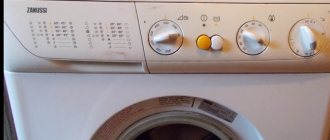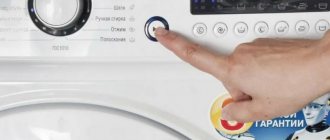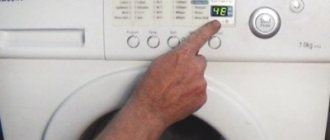Freezes immediately after turning on
Most washing machines are equipped with a light indicator or display. If, after the laundry is loaded, the washing mode is selected and the “start” button is pressed, nothing happens, then the washing machine is frozen. The complete absence of signs of operation indicates a malfunction caused by one or more reasons. The reasons may be the following:
- Water getting into the electrical part;
- No water access;
- Electronics failure;
- User error;
- Malfunction in the hatch locking device;
- There is a fault in the control module.
If, after 20-30 seconds after switching on, no water is drawn, then this may indicate simple forgetfulness of the user who did not open the water supply tap or the failure of the inlet valve. The second and quite common cause of freezing is overloading the washing drum, especially on new models with direct drive; it can also be due to the machine being unevenly leveled.
Manufacturers of household appliances LG or Indesit equip washing machines with appropriate indicators that indicate an error. In addition, if the machine freezes, an error code may appear on the information display, deciphering which you can determine the cause of the malfunction.
Error codes may differ for different manufacturers; you can find them in the documentation that comes with your automatic machine. For example, in Hotpoint-Ariston units without displays, when you select any program and try to start, the red warning light for the hatch lock starts flashing, but no water is drawn. The reason for the machine freezing in this case may be the condition of the motor's carbon brushes, replacing which can eliminate the problem.
Sometimes, as a result of a power surge, a temporary failure may occur in the electronics of the washing machine. In order for the unit to work, sometimes it is enough to either simply restart it by pressing the “start” button, or restart it after disconnecting from the power outlet for 20-30 seconds.
A malfunction of the sunroof lock can also cause freezing. In this case, the lock itself may be damaged mechanically, or the operation of its electrical part may be disrupted. In any case, if the lock does not block the hatch, water will not enter the drum and the washing process will not begin.
Simple reasons that you can deal with yourself
Stopping and freezing are not always associated with global problems. It happens that due to inattention, the user chose the wrong cleaning mode, put things in the drum incorrectly, or the drain hose became bent/clogged. These and many other faults can be easily fixed with your own hands.
Program selection error
This problem is usually encountered in the middle of the wash cycle. The machine started working as usual: it heated the water, carried out a preliminary and main wash, and suddenly went silent. In this case, the door is blocked and the water does not drain.
In this case, you need to check which operating mode of the device is set. If it is a “delicate” or “hand wash”, then the drainage and spinning are automatically turned off. Simply turn the mode switch to the desired position and repeat the washing process. Some machines have an additional rinse and spin function. Using this option, you will be able to complete the wash.
Overload of laundry
Overloading a washing machine causes a lot of troubles, some of which will be noticeable immediately, while others will appear after some time. If the washing machine freezes immediately after turning on and selecting a program, you need to check whether there is too much laundry loaded into the spinner.
It is very important to ensure free rotation of the laundry in the drum of the machine. This is the only way to achieve uniform distribution of water and powder, and therefore quality cleaning. An overloaded drum puts great force on the bearings of the device, which can result in failure or breakdown of the unit.
Before you start using a new appliance, you should read the instructions about the norms and rules for loading laundry. Each machine is equipped with a special sensor that monitors the weight of the drum with laundry and will not allow washing to start if it is overloaded.
To correct the situation, you need to turn off the machine and take out some of the things, postponing cleaning them until next time.
Imbalance
When loading laundry into the machine, you must not only follow the weight recommendations, but also ensure that the items are evenly distributed in the drum. If the machine has filled with water, turned the drum several times, but is not going to start washing, you can suspect the presence of an imbalance.
The cause of this problem may be improper loading of clothes and other things into the machine. Before washing, buttons and zippers on the products are fastened, items with Velcro are placed in special bags, and bulky rugs, pillows and blankets are washed separately.
You can deal with the problem as follows:
- disconnect the device from the network;
- drain the water using the drain filter located at the bottom of the unit;
- open the hatch;
- sort out the laundry, arrange things evenly in the centrifuge.
After this, you can set the desired program and restart the device.
Clogged water supply or drainage system
If the washing machine does not switch from wash to rinse mode, it can be assumed that the drain filter, pipe or drain pump is clogged. Waste water carries with it threads and lint, particles of dust and dirt, and sometimes much larger debris, such as coins, pins, paper clips that have fallen out of pockets.
To prevent this “wealth” from entering the sewer pipe, a drain filter is provided. Over time, it becomes so clogged that it is unable to pass water. As a result, the unit does not switch to rinse and spin mode, and the washing cycle stops.
In this case, you need to determine where exactly the fault is hidden: in the machine, the drain hose or the general sewer.
- Inspect the drain hose and straighten any kinks.
- Eliminate the possibility of blockage in the sewer. To do this, the end of the drain hose must be disconnected from the sewer pipe and directed into a bathtub or bucket. Start draining the water. If the water still does not drain, then there is a problem with the machine. Otherwise, you need to clean the sewer pipe.
- Remove and clean the filter located in the lower right corner of the device.
This simple procedure will bring the device back to life. If you empty your clothing pockets of debris and small items before washing, you will need to clean the filter no more than once a year.
Washing machine freezes during washing
If the selected washing program starts working and the machine freezes, the reason can be identified by indirect signs preceding the stop in operation:
- hissing and intermittent operation of the electrical winding of the inlet valve with characteristic clicks may indicate that the water in the water supply has run out and the unit has not collected the required amount of water for washing;
- a hum or crackling sound in the area where the engine is installed, after taking in water, and freezing of the machine indicates a malfunction of the motor itself or its drive;
- freezing at the stage of draining water may indicate a malfunction of the pressure switch, pump, or clogging of the drain filter, pipe or hose;
- stopping with a sound and light signal, indicating an overload of laundry, may be the cause of failure of the hall sensor in the motor.
Troubleshooting Samsung machines
Samsung washing machines may freeze at the end of the wash cycle. Interestingly, it all depends on the mode. If this is a delicate wash, it may hang on the rinse cycle, and the water drains, but not completely.
If the Economy mode is selected, then during the spin cycle it does not gain speed. This also applies to the Wool mode.
In this case, it is worth changing the pump. You may find that when stuck, the washing machine runs at low speeds when rinsing or spinning.
To solve the problem, you should buy a new pump, install it and start an empty washing machine by pressing the Spin mode. If it drains water, then the pump is working.
Stuck during spinning and rinsing
The washing machine freezes in the spin and rinse mode most often due to the following reasons:
- imbalance of laundry in the washing drum;
- disabling the spin function on some washing programs;
- in a faulty laundry balance sensor
- heating element malfunction.
Many models of washing machines restore the balance automatically before spinning, since the spin itself occurs at a high drum speed. Incorrect alignment can cause very strong unwanted vibrations that can move the unit from its place. Some models do not have this function, so if it freezes, you need to manually distribute the laundry around the drum. To do this, you can switch the machine to “pause” mode, wait for the hatch to open, distribute the laundry and continue washing.
On some Hotpoint-Ariston models, all the lights begin to blink orange, this may indicate a malfunction of the heating element - the heating element. You can check this by setting the washing program at high temperature. Next, during the washing process, you need to touch the glass from the loading hatch; if the water is cold, then the heating element is not working and needs to be replaced.
Troubleshooting Indesit machines
Washing machines of this brand may freeze when rinsing or spinning clothes. This may reveal related problems.
They may freeze if the display board is broken. This occurs due to a violation of the thermal insulation of the internal parts of washing units.
Reasons for failure:
- the engine is faulty;
- due to old bearings, play has formed in the drum;
- The heater wire has failed;
- drum defect;
- The heating element is broken;
- The tachogenerator or pressure switch does not work;
- the filter is clogged;
- the contact angle between the rotor commutator and the brushes is broken;
- control module is faulty;
- incorrect load - either too much laundry or too little.
The cause of freezing can also be insufficient amount of laundry in the drum. You should follow the instructions and load the amount of laundry prescribed for a specific model.
We recommend reading: Malfunctions of the Indesit washing machine.
This video explains why the Indesit washing machine freezes; an example is shown on a front-loading model.
Stuck at the last minute or in drain mode
When the machine freezes at the very end of the wash, without completing the process, or on the drain, the pump or heating element is most likely faulty. In addition, freezing at the beginning of the wash, and at the same time, can also indicate a malfunction of the heating element.
Considering that the electronic content of any washing unit consists of parts (“hardware”) and software (“software”), freezing may be the result of a malfunction of one or the other component. For example, the software (firmware) is broken and does not give a signal to complete the washing or draining mode. The signal may also not pass through due to malfunctions in the processor or microcircuits.
Stuck in the drain mode may also indicate that foreign objects have entered the pump and are blocking it, as well as a clogged drain pipe or hose.
The washing machine does not rinse clothes well
If the washing machine does not rinse the laundry or does it poorly, there may be several reasons for this, from the simplest and most banal to the complex and unpleasant. Here are a few situations when the reason does not lie in the breakdown of the unit:
Overload. If you load too much laundry into the machine, there is not enough space for the washing powder and it does not dissolve well. It gets caught in the folds of clothes and does not have enough contact with water.
A large amount of powder. Sometimes white streaks remain on laundry because the amount of powder much exceeds the volume of water provided for rinsing. To eliminate the problem, just run an additional cycle several times.
Low water pressure. Insufficient pressure occurs for two reasons:
- problems with the entire water supply system;
- The hose supplying water to the unit is clogged.
In the first case, you cannot do anything, you just need to wait until the situation improves. In the second, you need to clean the supply pipe and the filter mesh installed at the entrance to the system, the rinsing program will work again.
If none of the above is confirmed, most likely the cause of the trouble lies in a breakdown of the washing machine itself.
See also -
How to repair the control module of a washing machine yourself
The drain pump is broken
The pump may fail while the machine is running. In this case, water will remain in the tank. The level sensor sends a signal to the control module, and spinning will not begin until the water is pumped out.
The pump needs to be replaced. You can do this repair yourself if you have the right tools and know how to do the work. You also need a pump that matches the brand used. The photo shows a frequently used pump in Indesit machines.
Drain pump
Drive mechanism failure
Bearing failure is one of the most common failures. It occurs on machines that are very worn out. When a bearing fails, the drum of the machine produces the sound of grinding metal as it rotates.
The drum rotates with difficulty. It cannot reach the required rotation speed, resulting in the washing equipment freezing. To eliminate this failure, you should replace the faulty bearing or purchase a new washing machine.
It should be noted that replacing a bearing is a very labor-intensive task. If there is no rumble and the bearings are in good condition, but the spinning of the laundry does not start, then you need to carefully listen to the noise the machine makes just before it freezes.
If the washer makes a slight whistle and there is a sharp drop in the rotation speed of the drum, then you need to check the condition of the drive belt.
A stretched drive belt slides along the pulley when the drum rotation speed suddenly increases, resulting in a drop in speed. A stretched belt must be replaced with a new one.
This is done as follows:
- Washing equipment is disconnected from the power supply and communications.
- Pull out the unit to a place where it will be convenient to work with it.
- The back wall of the machine is dismantled.
- Remove the stretched drive belt. To do this, you need to take it with one hand and rotate the drum pulley with the other hand.
- Place a new belt on the electric motor pulley. Next, slowly rotate the drum pulley and put a belt on it. Then you need to make sure that the belt sits well on the pulleys.
- Reassemble the machine in reverse order.










